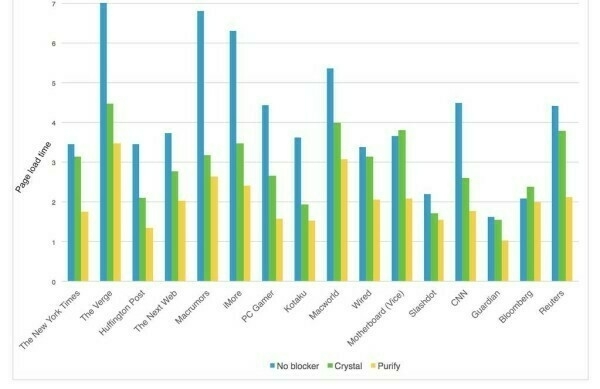Long Form
Purify Allows An Ad-Free Glimpse of Pure Mobile Web
Folks - earlier this week, I was given beta access to a piece of software that is going to be extremely controversial and disruptive to the way the Internet works. But with what we’re getting, the trade off is completely worth it. What happens from here is for the rest of the Internet to decide…but until that occurs, let us embrace the disruption of Purify, a new content blocker app available soon for iOS.
Today brings the release of iOS 9, the long-awaited new update to Apple’s operating system which powers the millions of iPhones and iPads used daily by an incredible number of users.
Say what you will about Apple - perhaps they “perfect" more than “innovate", perhaps they have too frothy a fanbase - but the fact is, their devices have become the way for countless people around the world to access the web, and access the web regularly. It’s where people get their news, read social media, read blogs and generally become one with the world wide web.
At the same time - the web is in a state of flux. The relationship between content consumer and content creator has been a troubled one for ages. The internet is ostensibly built around the idea of dramatic amounts of information available at your fingertips, absolutely free (minus your Internet bill, whether cellular or coaxial). To keep providing readers free content, the eyes of the viewers are exposed to countless ads. These advertisers pay for the exposure, which keeps the flow of content coming in. But now - more than ever - users don’t want to be exposed to ads.
Ads track what we do from site to site. Ads get in the way of our content. Ads try to figure out who we are, what we want to do, and how we can best be sold. In a post-Snowden world, this worries people. And more than that - these ads, and the scripts and trackers that support them - are bloating the web at unreasonable proportions.
Having been an avid internet user since the late 90’s, I’ve seen countless ads types. Banner ads, flash ads, whatever that old IGN process was which resulted in a giant ad for Tim Burton’s Planet of the Apes to “crash" through the screen with a sound clip of Michael Clarke Duncan yelling “BOW YOUR HEAD". (That certainly showed my tracks during some bleary-eyed late night IGN reading as a teenager. Sorry, Mom.) But as frustrating as those were, we grew out of them. For a bit. Google ads showed us the way. Simple, contextual advertising that you could see, not be distracted by, and move on, if you wanted.
For a while, that was great…but that was the problem. You could ignore it. And with an age of growing readerships, but declining revenue, websites are doing anything and everything they can to keep the lights on and the sites going.
I’m not the first to discuss this. Some people much brighter than I have written about this, such as The Verge’s Nilay Patel (who oddly puts the blame on the browsers themselves?), known tech blogger Marco Arment, Apple super fan John Gruber, iMore’s Rene Ritchie, and even The Guardian had a hot take on it.
We’re in an age of declining attention spans, limited mobile bandwidth, and a want to serve content and advertising at an even kiel.
So how do you solve it? If you’re Apple - you make the decision to allow content filtering applications for Safari in iOS 9.
Purity - the main reason why I write today - is developed by the same person who took over the open-source ad-blocker UBlock. And based on my time with the software, it could not be more simple, more elegant, and more delivering of what the mobile web should be.
Check out this YouTube video showcasing the difference.
The clutter, the noise, the distraction of the modern web experience - gone. All that’s left is brilliant and simple content.
Installation and usage could not be more simple. Download the app from the app store, and..that’s really it. Load times, dropped. Page sizes, nullified. Your privacy, retained.
Want to whitelist a site to ensure they get the advertising dollars from your exposure? Tap the share-sheet icon in Safari (like you’re sharing to Twitter or Facebook), and there will be a button for Purify, where you can whitelist the domain.
They’ve even shared graphs on their Twitter account, showcasing real differences in load times between sites without a content blocker, and with a content blocker. (Crystal, referenced there, is a rival to Purify)
I’ve seen it myself. I’ve experienced it myself. And honestly, I can’t imagine my phone ever not having this app on it. It - like TweetBot and Reeder before it - will grow to define my iOS usage. And because it is so easy, because it is so simple, and because it shows the inelegance of the current model…content creators should be excited, and very, very scared.
We live in an age where people are cutting cords, not wanting to watch ads on TV, not wanting to be marketed to at all times. And now, with apps like Purify, the phone will be another battleground lost.
At some point, we as content absorbers must find the proper balance with the content creators…but so too must the creator with its audience. Thankfully, with an app like Purify, the power is back on the side of the audience. Now, it’s time to see what develops next.
Purify will be available later today in the iOS app store. A beta copy of the software was provided for testing, but this article was written without any request from the developer.
Wednesday September 16, 2015
